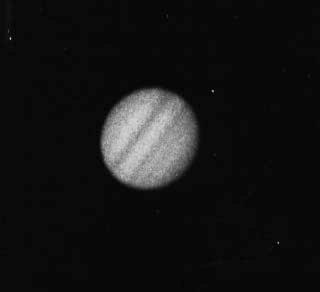
C-14 Image of Jupiter taken at Cunningham Observatory by Bo Reily. For other images taken during classes or in independent studies courses, click here
ASTRONOMY 110 OBSERVATIONAL ASTRONOMY HOMEPAGE
Class meetings will be Tuesday and Thursday evenings. Weather permitting, we will try to observe for 2-3 hours on Tuesday and/or Thursday evening, and a shorter time on the other night. There need to be about 4 class hours a week.
There will be occasional daytime sessions, TBA, to observe the Sun. We will also take at least two field trips across the lake to dark skies, TBA.
The class will be broken down into three groups (most of the time), with each group working on a separate observational project. You will be expected to have a standard lab notebook in which to record and write up each laboratory project. These will be turned in periodically for assessment. Acceptable notebooks are: Computaton Notebook ($15) or "Research Laboratory Notebook ($25), or any other notebook with graph paper pages. You should have a bottom-of-the-line scientific calculator (about $12) that will have logarithms and trig functions.
Course grades will be determined by lab reports (including, perhaps, a
subjective decision on the relative contribution of each member of a
team), plus a brief final examination. Near perfect attendance will be
essential.
If you have a 35mm camera and would like to use it, you will have to obtain
a "T-adaptor" for $10 or so from a local camera shop.
You may want to consult the general astronomy page at http://www.tulane.edu/
~danny/astronomy.html.
General Summary:
We will do all or some of the following projects; about two weeks will
be devoted to each project, but that will vary depending on the difficulty
of the project, success with weather, and how quickly the project
proceeds. For detailed descriptions, see below.
1. Orientation and Visual observatons
a) measuring binary star separations
b) measuring height of lunar mountains
c) measuring planetary diameters
d) observing and drawing the bright planets and the moon
e) observing and drawing clusters, galaxies and nebulae
f) observation of meteor shower(s)
g) minima of Algol (eclipsing binary)
h) observation of Mercury
2. a) Planetary and Lunar Photography
Photography of a) the Moon, b) Saturn, and perhaps Jupiter and Venus
b) "Deep-sky" photography
Photography of 1) binary star systems, 2) Orion nebula, 3) Pleiades, and
if field trips are successful, 4) one or more galaxies, 5) other objects
such as the Ring Nebula, a globular cluster, etc. May include photography
of Barnard's star and measurements of proper motion.
3. Spectroscopy
Observation and photography of the spectra of the Sun and a few bright
stars. Identification of spectral lines and spectral types.
4. Photoelectric photometry
Photometric observations of stars, especially variable stars, in
particular, Algol. Introduction to and calibration of photometer.
5. Solar observations
a) observation and photography of sunspots
b) observation and photography (perhaps video) with H-alpha filter
c) observationa and photography of solar spectrum
6. Acquiring CCD imagery of planets and stars
Use of CCD camera to acquire images of Saturn, Moon, binary stars
7. Variable stars
Visual observations of variable stars, including long-period variables
(Mira, R Leonis?), and eclipsing binary Algol.
8. Internet observing projects